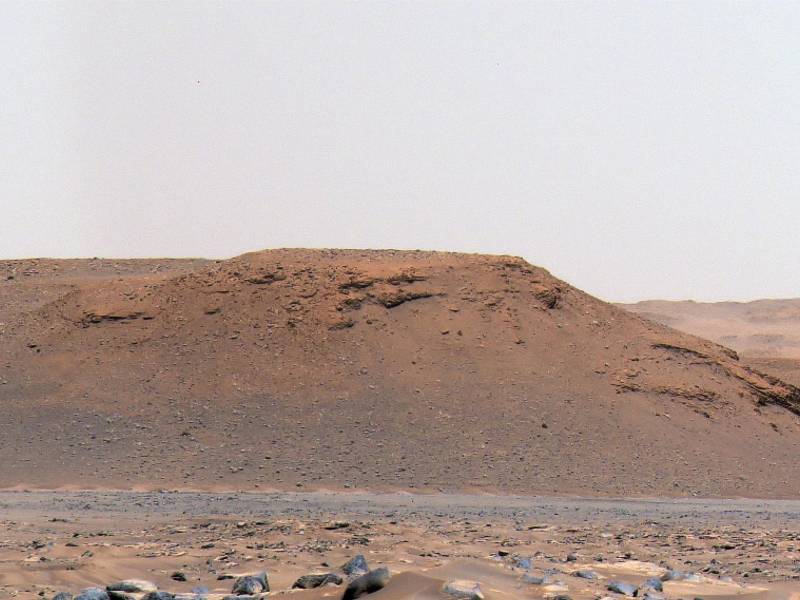About 3.7 billion years ago, it was Jezero Crater on Mars It was a calm lake fed by a small river, and after a sudden change in the climate, it began to experience a sudden and lively flood that washed away large boulders of tens of kilometers from the source to the bottom of the lake, where they still linger.
Until now this was an assumption for scientists, but for now, the first analysis of the images taken by the rover NASA Perseverance has confirmed it: Jezero Crater, now a dry, windswept depression, was once a tranquil Martian lake.
The pit chosen as the rover landing site After satellite images showed that this place was similar to river deltas on Earth, it has just been studied and the results are published today in the journal Science.
Led study Scientists from NASA and the National Center for Scientific Research French, and co-researcher from the Institute of Geosciences (IGEO) Jesus Martinez-Frias.
LEA: NASA prepares to launch Landsat 9 satellite to monitor Earth’s ecosystems
“These geological studies of rocks and outcrops on Mars conducted by Perseverance confirm their importance in identifying ancient Martian environments (ancient environments) and in establishing their relationships with water and living conditions,” explains Martinez Frias, in remarks to EFE.
By Benjamin Weiss, a researcher at the Massachusetts Institute of Technology And a study co-author, when you look at the photos, “You’re basically looking at this epic desert landscape. The most desolate place you can visit. There’s not even a drop of water anywhere, and yet there is evidence of a completely different past. Something very profound has happened in the history of planet.”
The rover landed on the floor of Jezero crater last February, less than two kilometers from the western part, but while NASA engineers remotely checked the operation of the rover’s instruments, two of its cameras, the Mastcam-Z and the SuperCam Remote Micro-photographer ( RMI) provides high-resolution images of the crater and a small mound known as the Kodiak butte.
What’s more: NASA will send a robot to the south pole of the moon in search of ice
When the rover sent them to EarthProcessed and combined by NASA’s Perseverance Science Team, they were able to observe the different sediment layers.
The researchers measured the thickness, slope and lateral extension of each layer, and found that the sediments were deposited not by wind, but by the flow of water into the lake, by floods or other geological processes.
“Without getting anywhere, the rover was able to solve one of the biggest unknowns, which is that this crater was once a lake. Until we actually landed there and confirmed that it was a lake, it was always anyone’s guess,” Weiss admits.
When the researchers looked at images of the main outcrop, they saw large boulders and boulders embedded in the smaller and higher layers of the delta; Some were up to a meter wide and weighed several tons.
very: NASA announced that the persistent rover has collected rock samples from the soil of Mars
The team concluded that these massive rocks must have come from outside the crater or several kilometers downstream, and that they were swept to the bottom of the lake by a flash flood that flowed up to 9 meters per second and moved into 3,000 cubic meters of water per second.
These massive boulders in the upper layers of the delta are the most recent material deposited, while the boulders rest on layers of older and finer sediments, an indication that the ancient lake was fed for most of its existence by a gentle flow. River.
With time, The crater suffered a sudden flood Large boulders were deposited in the delta, and later climate change – whose origin is unknown – caused the lake to dry up. Over the following billions of years, winds eroded the landscape and created the crater we see today.
As the rover explores the hole, Scientists hope to discover more clues about the climatic and hydrological evolution of the red planet because if Jezero was a lake environment, its sediments might contain traces of ancient aquatic life.
In his next mission, Perseverance will search for places To collect sediments and samples that they will send back to Earth for scientists to search for the biosignatures of Mars.

“Proud web fanatic. Subtly charming twitter geek. Reader. Internet trailblazer. Music buff.”

:quality(85)/cloudfront-us-east-1.images.arcpublishing.com/infobae/TEQF6EONZRFGLLLDIDD4L2O4EE.jpg)

:quality(75)/cloudfront-us-east-1.images.arcpublishing.com/elcomercio/XU32LRAEZFDDPNVHLFU3CKVBYY.jpg)



More Stories
How to create 3D videos with my iPhone, it will be very useful even for your business
NASA discovers an anomaly in the Earth’s magnetic field that could have serious consequences for humans
Can the Earth be divided into two parts?